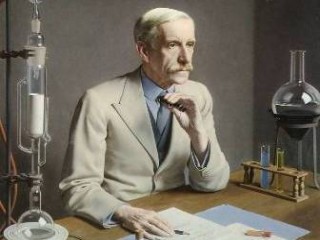
Frederick Hopkins biography
Date of birth : 1861-06-20
Date of death : 1947-05-16
Birthplace : Eastbourne, England
Nationality : English
Category : Science and Technology
Last modified : 2011-12-20
Credited as : Biochemist, discovered the vitamins, Nobel laureate
3 votes so far
English biochemist Frederick Hopkins was raised by a widowed mother and a disinterested uncle, and was expelled from high school for truancy. He became an insurance salesman, and after attending night classes in chemistry, worked for several years as an assistant in a criminal forensics lab. It was not until he was 28 years of age that he could afford tuition to medical school.
Despite his late start in science, he won the Nobel Prize for his discovery of vitamins. He was among the first to envision the cell as a chemical machine. He discovered tryptophan, an important amino acid, then proved that tryptophan and other essential amino acids could not be manufactured by the body, but had to be supplied through proper diet. Intrigued by Christiaan Eijkman's somewhat similar findings on the importance of proper diet, Hopkins then oversaw a study that proved rats' growth is impeded when fed all the known ingredients of milk -- fats, proteins and carbohydrates -- instead of milk itself. His work established that unknown trace substances he called "accessory food factors" were present in milk, and his papers on the topic were the first to explain the concept of vitamins.
As he conducted some of his most important research, he augmented his rather meager academic income by returning to work part-time at the forensics lab, and working as a teacher. In 1914, he received a raise and became the first Professor of Biochemistry at Cambridge. In other studies, he isolated glutathione, then showed that it is a tripeptide of glutamic acid, glycine and cystein, and he discovered pterin, a chemical compound essential to the coloring of butterfly wings. Working with Sir Walter Fletcher, he proved that muscles accumulate lactic acid. He was knighted by King George V in 1925.
The poet Gerard Manley Hopkins was his distant cousin. His daughter, author and archaeologist Jacquetta Hawkes, was one of the first women to study archaeology at Cambridge. She found the Neanderthal Tabon Skull, took part in excavations in Britain, France and Palestine, wrote numerous books including Atlas of Ancient Archaeology, and encouraged a young David Attenborough to pursue his interest in fossils. She was also an activist against nuclear proliferation and in favor of equal rights for homosexuals and bisexuals. Her second husband was playwright J. B. Priestley.
During his life, in addition to the Nobel Prize, Hopkins was awarded the Royal Medal of the Royal Society in 1918 and the Copley Medal of the Royal Society in 1926. Other significant honours were his election in 1905 to fellowship in the Royal Society, Great Britain’s most prestigious scientific organization; his knighthood by King George V in 1925; and the award in 1935 of the Order of Merit, Great Britain’s most exclusive civilian honor. From 1930 -1935 he served as president of the Royal Society and in 1933 served as President of the British Association for the Advancement of Science.
He died on May 16, 1947 in Cambridge, England.
Author of books:
-Newer Aspects of the Nutrition Problem (1922, research)
-The Problems of Specificity in Biochemical Catalysis (1931, research)
-Chemistry and Life (1931)
-An Introduction to Comparative Biochemistry (1949, textbook, co-author Ernest Baldwin)
















